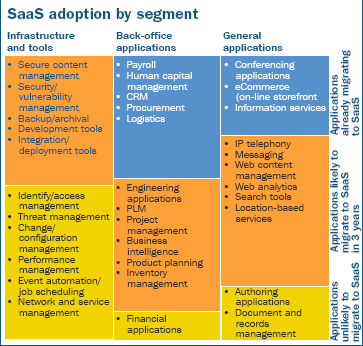I’m sitting at the Office 2.0 conference watching a barrage of 5-minute product demos. FreshBooks‘s CEO just dropped a bomb at the last 20 seconds in his presentation: being software as as service, they can aggregate customers’ data, categorize it by industry, size ..etc, and once they do that, why not turn it into a product?
Customers can receive generalized metrics as well as benchmark themselves against their peers.
Stop here. Think about it. This is big. It’s not about FreshBooks. It’s *the* hidden business model enabled by SaaS. It is so logical, we all had to know it would be coming – but carefully avoids talking about it. No wonder… SaaS adoption is growing but still at an early stage, and security, trust concerns are huge. The last thing software vendors want is to feed those concerns, i.e get their customers worried about the competition accessing their data.
The benefits are obvious: all previous benchmarking efforts were hampered by the quality of source data, which, with all systems behind firewalls was at least questionable. SaaS providers will have access to the most authentic data ever, aggregation if which leads to the most reliable industry metrics and benchmarking. Yet it raises a number of serious questions: How far can they go? What are the security / confidentiality / privacy implications? Are they reselling data that the customer owns in the first place? If the customer owned the core data, who owns the aggregate?
The business of metrics, benchmarking is potentially huge, but it can’t take off until the industry, along with customers, can answer these questions – and more.
Update (10/16): I’ve just checked who else talks about this Unheralded SaaS benefit, and voila! Two posts from fellow Enterprise Irregulars, ex-Gartner Vinnie Mirchandani and Yankee Group’s Jason Costello.
Update (10/30): Read Dennis on Valuing Data and on Freshbooks.


 Quick news from the press conference at SAPPHIRE 2006: Shai Agassi has just announced the all-cash acquistion of
Quick news from the press conference at SAPPHIRE 2006: Shai Agassi has just announced the all-cash acquistion of  as Leo Apotheker clarified during the Press Conference, over time all SAP’s offering will be made available in the “hybrid” model.
as Leo Apotheker clarified during the Press Conference, over time all SAP’s offering will be made available in the “hybrid” model.

Recent Comments